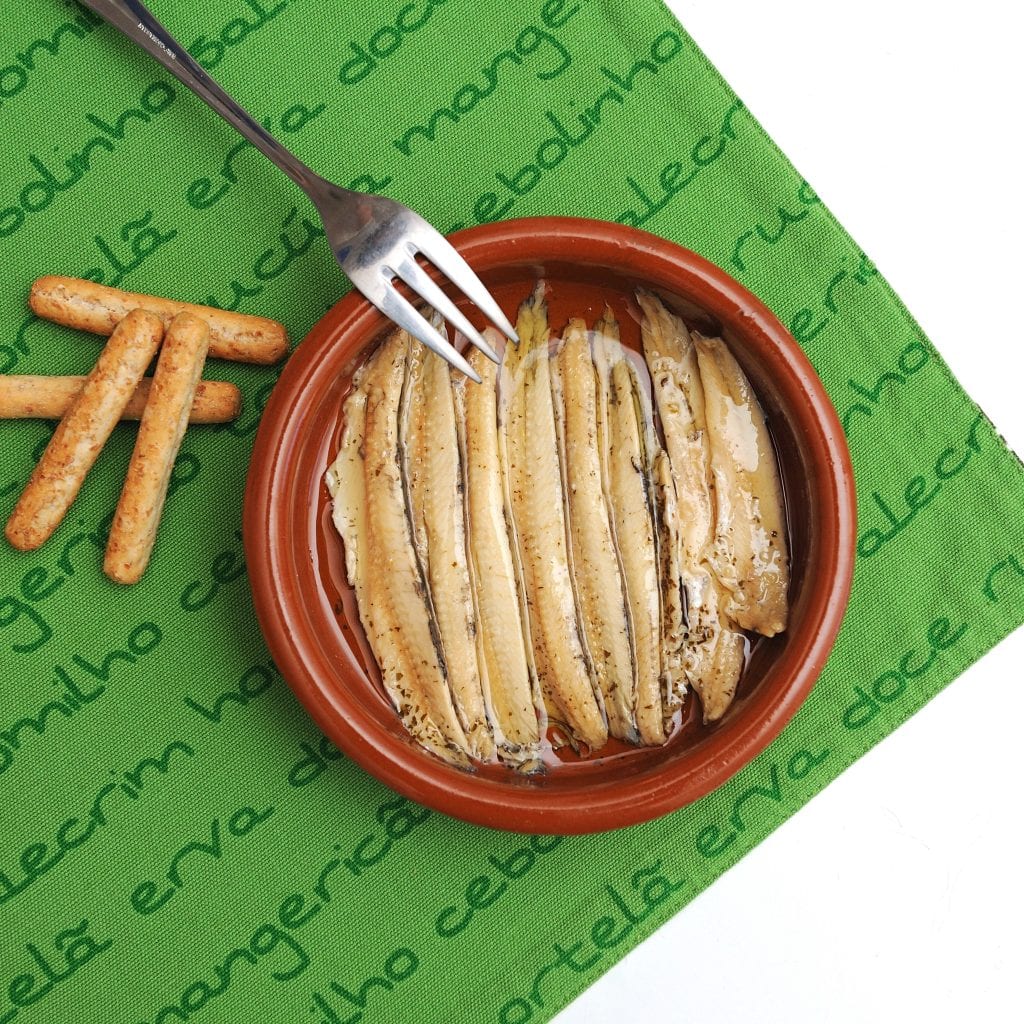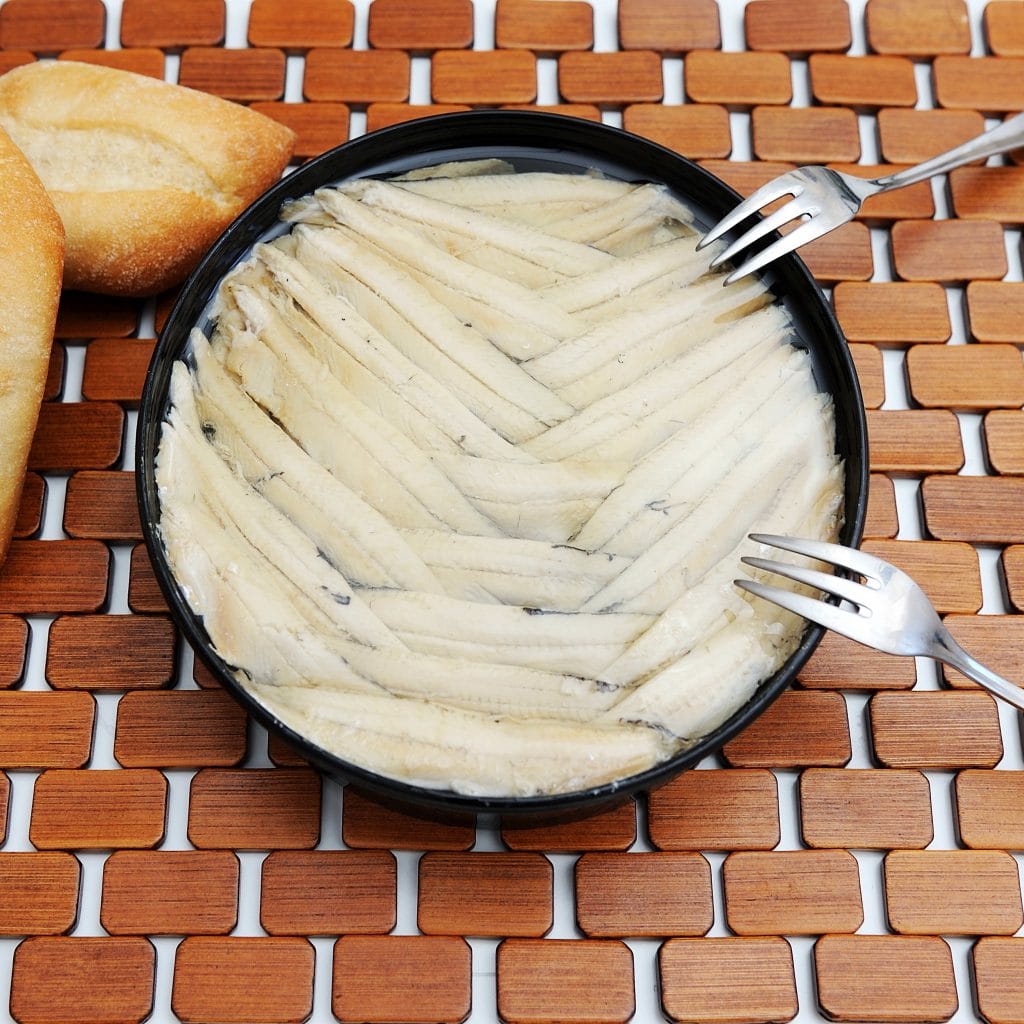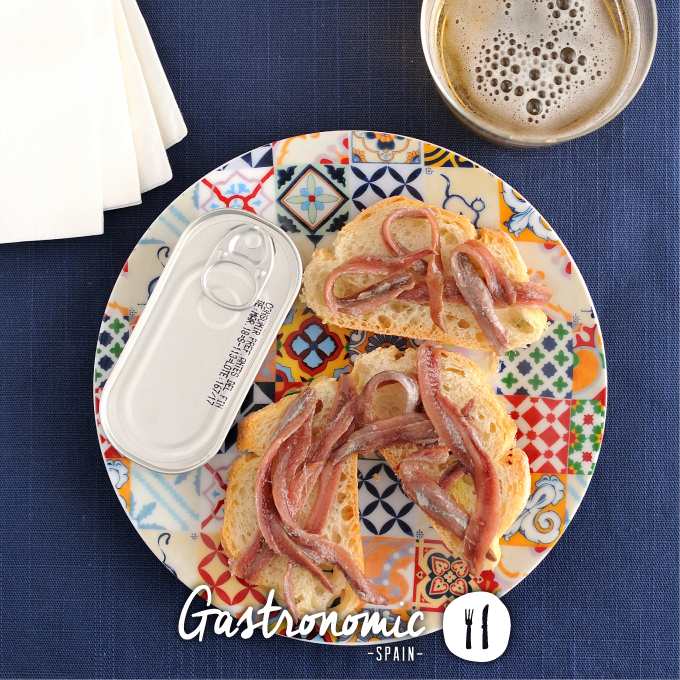Meet the couple of the year! And not because it is Valentine’s Day, but because boquerones and anchovies are the perfect marriage. A rubbed tomato toast with boquerones and anchovies on top… my mouth is watering! Now, we are going to detail all the relevant aspects of the boquerones and anchovies, because we are aware that it is summer, and we are facing one of the most typical tapas in this season. If you live abroad and are interested in our boquerones and anchovies, here you can see our catalogue. You have FREE shipping all over Europe.
Let’s go!
Are boqueron and anchovies the same?
Many of you will be wondering about this, and Gastronomic Spain will put an end to your doubt. We have to take into account is that both belong to the family of blue fishes, specifically to the Engraulis encrasicolus species, also known as Bocarte. But the difference is in the way each of them is made. We refer to anchovy or Bocarte when the fish is consumed fresh. But if the product is elaborated, it is called anchovy when it is processed with salting, whereas it is called boquerón when it is processed with vinegar. Simple and easy. Therefore, boquerón and anchovies are the same, but they are called differently depending on the production process, in other words, depending on how they are served or how they are bought. Now we will delve into the world of each one of them: boquerones and anchovies.
Boquerón
Boquerón is highly appreciated in Mediterranean cuisine, for its taste and smooth texture. It is a small fish that abounds on the Spanish coast and, for decades, it is common to see it in homes, bars and restaurants. Boquerón is, therefore, one of the fish most consumed by the Spaniards.
Preparation of boquerones en vinagre
Boquerones en vinagre is one of the most typical tapas or snacks of the Spanish cuisine. Its main ingredient, obviously, is boquerón, a small fish whose loins have been previously marinated in vinegar, garlic and parsley. In its preparation, the clean loins of the boquerón are used, which have a brown-looking flesh and stand out for the silvery reflections of their outer skin. Boquerones are placed in a glass tray (never metal because it would be damaged by the acetic acid of vinegar) with salt and water, for 3 hours. And then, we put them 6 more hours in vinegar. Important: in a cool place.
The loins of the boquerones, which were previously brown, will turn white as the vinegar takes effect. After that, and once the liquid has been drained, it is garnished with plenty of chopped garlic, olive oil and parsley, and then served. If you want more information about this delicious dish, do not hesitate to read our post of boquerones en vinagre.
Types of boquerón
When we decide to consume boquerones and anchovies we find many varieties in their elaboration. The most typical and popular is boquerones in vinegar, explained above, but there are also other preparations. The different types of boquerón are:
Fried boquerones
Boquerones fritos is one of the most typical dishes of Andalusia, but it is already widespread throughout the peninsula. This oily fish is very tasty when fried. Boquerones, flour, water, salt, and oil are the necessary ingredients to prepare this delicious dish.
Lemon boquerón
Lemon boquerón is, as boquerones en vinagre, one of the most popular fish recipes when you have to take an aperitif. Easy, fast and tasty. The elaboration process is the same as the fried boquerones but adding a dash of lemon on top. In this way, it will be highly flavoured.
Anchovies
As we mentioned above, boquerones and anchovies are an elaboration and come from the Bocarte fish. Unlike boquerones, anchovies are a clean Bocarte fish, cured and matured in salt for 6 months. Among the most popular anchovies are the anchovies of the Cantabrian Sea, which stands out for their fine texture and intense flavour.
Preparation of Cantabrian anchovy fillets
Cantabrian anchovies are produced using the salting technique. This is a very traditional technique for preserving fresh anchovies and it consists in covering the food with salt to make it available for consumption in a longer period of time.
First, the fresh anchovy must be salted and put in brine. Then, the anchovy fillet is removed from the brine and the head is removed and gutted. This is why it is sometimes called anchovies in salt. A layer of salt is then added to the base of the container in which the anchovies are to be conserved.
On top of this base, a layer of anchovy fillets is placed, then another layer of salt is added and again another layer of anchovies. In this way, layers of anchovies are formed between layers of salt.
A lid is placed on each container and on top of it a weight (cement block), which serves as a press and whose purpose is to dehydrate and degrease.
After about a hundred days, the fish has already matured, turned a reddish colour and the right aroma. Therefore, the lid is removed, the inside of the can is cleaned with brine and covered with salt and, then it is definitively closed it hermetically. We usually find on the market canned anchovies, though sometimes it comes in glass jars or plastic tambourines. Unlike canned fish and seafood, canned anchovies need to be cold. It is a semi-preserved. Inside we can find the anchovies in olive oil or sunflower oil.
Other varieties of anchovy
Besides coming from the Engraulis encrasicolus, there are other varieties of anchovy of different quality levels:
• The Engraulis Anchoita, which is located in the seas of Argentina and Uruguay.
• The Engraulis Ringen, also known as the anchoveta, is found mainly in the seas of Chile and Peru.
• The Engraulis Mordax, located in the seas of California, in the United States.
• The Engraulis Japonicus, located between the seas of Japan and China.
• The Engraulis Capensis, we can find it in the seas of Namibia and South Africa.
• The Engraulis Indicus, is mainly located in the seas of India, the Persian Gulf and Madagascar.
Where can you buy boquerones and anchovies?
Now that you have become an expert, I am sure that you would like to know where to buy anchovies and boquerón in oil. I am sure that you are hungry and if you are also one of those who live abroad. You must know that this is a Spanish product that is very difficult to get. Gastronomic Spain offers you a wide variety of boquerones in vinegar and Cantabrian anchovies. Don’t hesitate to consult our entire catalogue, because among it you will find the best boquerones en vinagre, as well as the best salted anchovies. These are some of the boquerones en vinagre and the anchovies you can find in Gastronomic Spain.
Cantabrian anchovies in vinegar: The Cantabrian anchovies in vinegar are a delicatessen They have a good size, are thick, fleshy, and with a perfect consistency. The vinegar dressing is balanced. It is possibly the best anchovy you will find. Would you like to buy anchovies in vinegar of this quality? Cantabrian anchovies: As you know, the Cantabrian anchovy is the most famous. Some canned anchovies of premium quality, of good size and perfectly de-boned and cut.
An excellent Spanish tapa. I advise you to eat them on a toast with a bit of grated tomato and the juice of the anchovy itself.
Cantabrian anchovies 00: The Cantabrian anchovies 00 are giant anchovies of the best quality. These anchovy fillets are perfectly placed in a tambourine. Fifty anchovy 00 fillets from the Cantabrian sea are equivalent to 500 gr. A real delight. Top quality anchovies in olive oil.
Canned anchovies: These canned anchovies in sunflower oil are perfect to complement your dishes, as in salad or toasts. They are very versatile anchovies. These anchovies in sunflower oil are a good resource to have in the fridge. As you can see, in Gastronomic Spain, you can buy anchovies of different types and in different formats. But also, if you are interested in other products such as Iberico hams, chorizo or other snacks, take a look at our website and you will be delighted.
FREE shipping throughout Europe.









